|
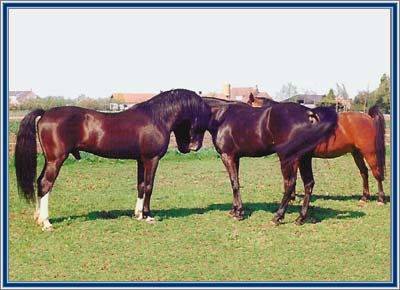
Lad's Black Buster in the
meadow, inspecting the two mares he has been breeding
already the day before. It's TWH Pride's Dutch Dixie and a gaited German
Trotter mare.
|
| We are
happy to be able to offer you various services. They
range from all aspects of breeding to advice and lessons
in training, riding and showing your Tennessee Walker or
your gaited horse. Horse haulage is also one of our
services.
Please check out the section ďOur StallionsĒ for information on our
currently available Tennessee Walking Horse studs and
their breeding fees. On the page ďBreeding ContractĒ you can notice some
other fees. All other services are handled on private
treaty. |
|
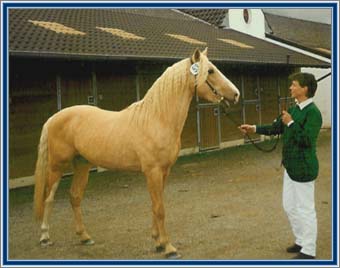
One of our activities is
presenting a stallion before an inspection
commission. Here's young
Buster's Fair Leroy at the premises
of the Rheinisches Pferdestammbuch in
Aachen, Germany.
|
Breeding a foal of
your own is a beautiful experience. Itís not
always easy though, to get a mare in foal
and surely in the process of pregnancy and
giving birth, diseases and even death are
lurking. Veterinary advice and treatment may
be crucial for a positive result. For that
purpose, we offer boarding for mares about
to foal, with veterinary supervision.
|
|
| For
breeding, we advise on the choice of a stallion, the
combination of bloodlines, avoiding hereditary diseases
and of course on veterinary aspects. Mares having
problems to get in foal can be inspected (rectally) and
treated at our farm. We also perform scanning for early
pregnancy detection. |
|
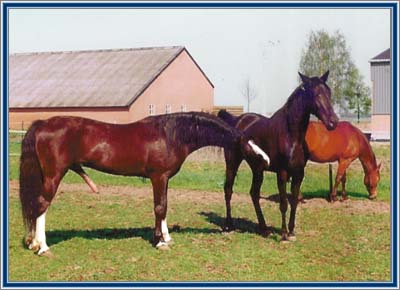
On further inspection of
Pride's Dutch Dixie's willingness to be
bred, Lad's Black Buster urges her at her
side. Although she
shows interest, on this occasion her heat was over and
Buster left her in peace.
|
| For the
actual breeding of your mare to one of our stallions
there are several possibilities. First, there is the
choice of natural breeding versus artificial
insemination. Natural breeding can be beautiful but
there are risks going with it. There is a greater chance
for transmission of venereal diseases as well as the risk
for harm by kicking or biting by the stallion or by the
mare. |
|
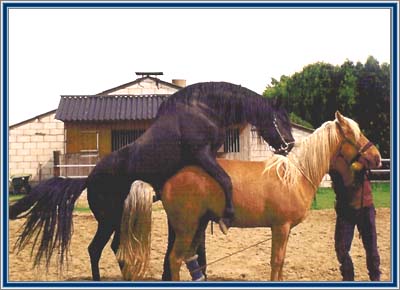
Postmark Delight breeding TWH mare, A
New Golden Time, with a second handler
holding the mare and the rope constraining a
hind leg,
which is arranged for immediate release if
necessary.
|
We handle your mare
and our stallion with care, always
estimating the readiness of the mare and
knowing about the behavior of our studs. If
deemed necessary, protective measures are
taken, like the restriction of a hind leg of
the mare. |
|
| There is
the possibility, if the mare is behaving well, to turn
her out in the pasture with her stallion, but only after
a successful breeding with both animals on the lead.
Artificial insemination has itís advantages but there
are extra costs involved, see the
Breeding Contract. Also, not having to
travel with your mare is a great bonus. |
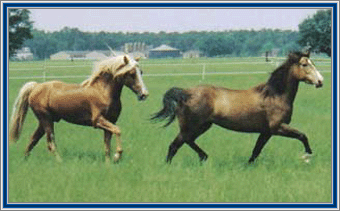
Buster's Fair Leroy and partbred TWH
mare Pearl (out of gaited German Trotter)
are roaming the meadow together for pasture
breeding |
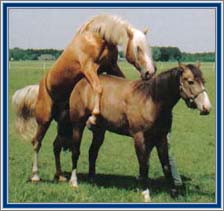
Here's an actual breeding
taking place. If you look closely, you see
that human aid is still offered at the near
side of the horses |
|
|
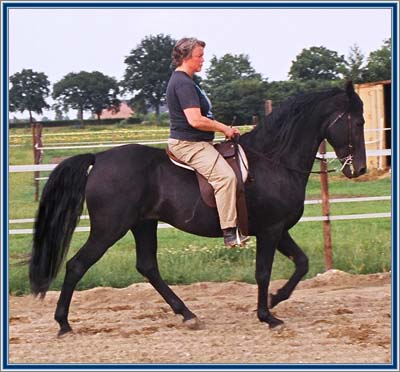
Postmark Delight and Maryan |
| As for
activities with your Tennessee Walker or your gaited
horse we offer advice and lessons for show and
competition, for training, riding and starting under
saddle as well as for driving. Our emphasis is on riding
the horse, but we surely can help with driving too. |
|
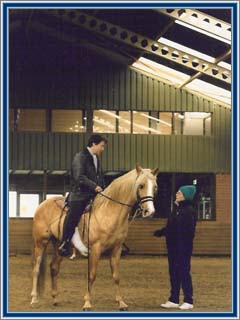
On
Buster's Fair Leroy, I received
advice from Diane Gueck, American TWH
trainer from
Cheveaux Stables in Oregon.
|
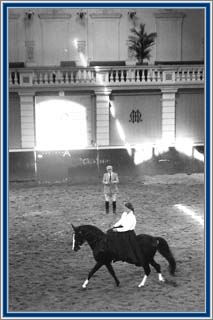
In the very heart of Amsterdam, the riding
hall of the famous Hollandse Manege, I
received side-saddle riding instruction by
Mr. Aafjes, on Lad's Black Buster.
|
|
| For
riding, we use three different ways or styles; two ways
to ride in English style and the Western style. For
English riding with a Tennessee Walker we use American
flat saddles (cut back saddles) and other gear designed
for this breed. Instruction is also offered for riding
side-saddle with an English Champion and Wilton saddle.
For Western style riding (Billy Cook saddle), we may
also use bitless bridles like a side-pull or Lindel.
Emphasis is laid on a correct riding style like
English-American equitation. We consider it of even of
more importance to ride with a light hand, guiding the
horse mainly with the seat and equilibrium and minimal
aids with the legs and over the bit. If youíre able to
ride your horse in several gaits including the canter,
without any tack, we consider you as an accomplished
rider. Fortunately for many of us, itís not necessary to
reach this stage to be a happy horse rider. Anyway, it
would be very foolish and irresponsible to go out on our
busy streets without any tack on the horse, no matter
how good the mutual understanding may be! |
|

Lad's Black Buster was taught to trot on
command at the lunge line.
|
| With
training, weíre eclectic, incorporating advice and
methods of many teachers. The lineup of teachers starts
with the Greek Xenophon, whose writings are well worth
reading! Lungeing is always a part of the training,
where it is used to assess the horse's development and
gaits to determine which disciplines it is best suited
for. Lungeing also offers a good opportunity to teach
the horse oral commands to go in a certain gait. With
starting under saddle we gradually get the horse
accustomed to the bit and the way itís used, by
combining a bit and a device to put some pressure on the
bridge of the nose. E.g. a plain flexible bit combined
with a short-shanked hackamore. A combination of being
patient as well as firm with the horse and also
understanding itís behavioral intentions, does deliver
results! |
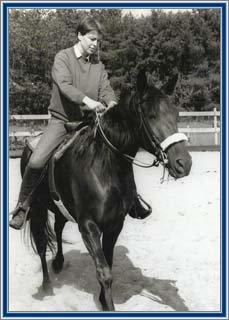
Pride's Dutch Dixie was started under
the saddle with a flexible bit (a Nathe
bit) combined with a short shanked
hackamore.
|
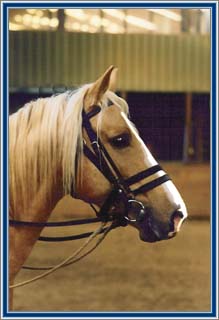
Here's young Leroy, already used to the
snaffle, with rope reins attached to a
halter for some pressure on the nose if
necessary.
|
|
| For horse
haulage, we can transport your horse with our truck and
trailer combination, e.g. for the transport of your new
horse imported from America! Usually, horses enter
Europe at Schiphol Airport, Amsterdam. It is also
recommended to fly with the K.L.M., the Royal Dutch
Airlines, as they provide utmost care and professional
handling of your horse. From there, we can fetch horses
and deliver them at their new address, with veterinary
supervision on the way and of course driven by a
professional and experienced truck driver! |
|
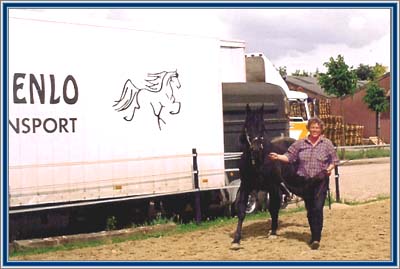
For a breeding on the lead,
Postmark Delight is being led towards
the mare, who is standing ready.
Our big horse trailer is visible in the background.
|
| Our big
horse trailer has conveniences like a kitchen and
sleeping places. Originally it was designed for
transport of six horses, but we added a storage room and
itís now modified for the transport of four horses.
Weíre used to driving all over Europe and also to
driving at the left side of the road in England, and
would be happy to deliver your newly imported Tennessee
Walker to your doorstep! |
|
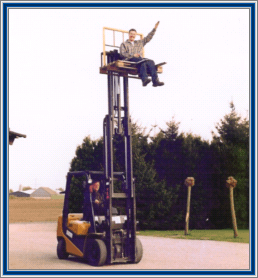
|
Henk and
his son Stephan with a "workhorse" they can handle very
well! |
 |
|
 |
 |